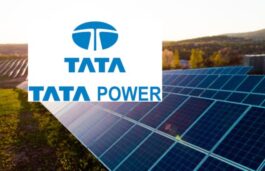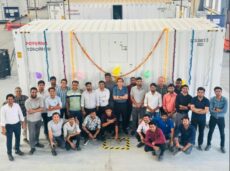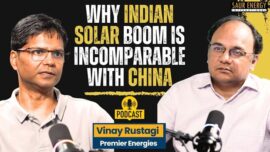Highlights :
- In 2018/2019 companies such as, JA Solar started production of wafers in Vietnam with an annual capacity of 1.5 GW, which was expanded to 4 GW in the first half of 2023. Companies like JinkoSolar followed with a 7 GW wafer plant in early 2022, and Trina Solar opened a 6.5 GW wafer factory in August 2023.
 Cyantron & Fasmho Energy Ink Deal For High-Voltage Battery Systems
Cyantron & Fasmho Energy Ink Deal For High-Voltage Battery Systems Germany based Bernreuter Research in its report on Polysilicon shipment found a drop in Polysilicon imports into China. The report stated, this fall has led to the lowest level since 2011.
According to the report the Chinese customs statistics, imports of the feedstock for solar cells and semiconductors slumped by 28.5% i.e., from 88,093 metric tons (MT) in 2022 to 62,965 MT in 2023. This volume is slightly less than the 64,614 MT reached in 2011.
“The non-Chinese polysilicon manufacturers Wacker, Hemlock Semiconductor and OCI Malaysia are increasingly shifting their shipments from China to Vietnam, where three of the four largest Chinese solar module suppliers have established wafer plants,” explains Johannes Bernreuter, head of the polysilicon market specialist Bernreuter Research. He also authored the Polysilicon Market Outlook 2027.
In 2018/2019 JA Solar started production of wafers in Vietnam with an annual capacity of 1.5 GW, which was expanded to 4 GW in the first half of 2023. Companies like JinkoSolar followed with a 7 GW wafer plant in early 2022, and Trina Solar opened a 6.5 GW wafer factory in August 2023.
US Regulations Trigger Wafer Production Facilities In Vietnam
Two influencing factors have pushed this development:
- On August 18, 2023, the US Department of Commerce confirmed its preliminary determination made in December 2022 that several manufacturers in Cambodia, Malaysia, Thailand and Vietnam, which produce solar cells or modules with wafers from China. These Chinese solar cells and modules are circumventing anti-dumping and countervailing duties on these companies which have to pay duties starting on June 6, 2024.
- On June 21, 2022, the Uyghur Forced Labor Prevention Act came into effect, which bans products made with forced labor in Xinjiang in northwestern China from entering the United States. Hence, the leading Chinese solar module suppliers began to create separate supply chains based on polysilicon from non-Chinese manufacturers for the export of solar modules to the US.: JA Solar could already build on a legacy polysilicon supply contract with Hemlock Semiconductor; Trina is a long-standing customer of Wacker, and Jinko closed two supply contracts with Hemlock and Wacker in September 2021.
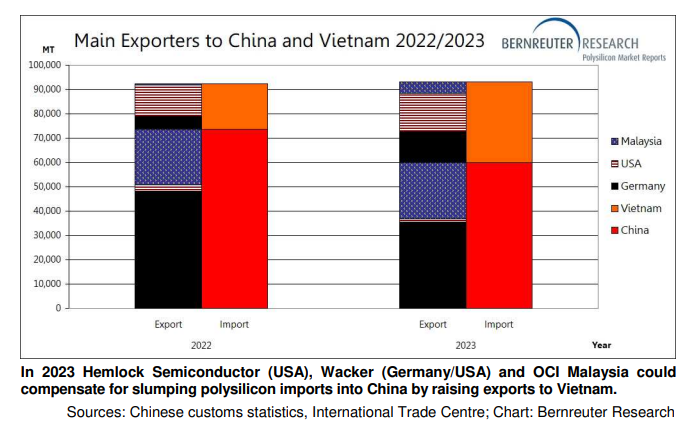
Polysilicon Import Vietnam Vs China
Soaring exports from China to Vietnam raise dobts about separate supply chains
Having the wafer production facility outside China makes it easier for the manufacturers to document at the US Customs and Border Protection (CBP) agency. It helps to ensure that no silicon metal or polysilicon from Xinjiang enter their supply chains for modules destined for the US. However, customs statistics show that polysilicon exports from China to Vietnam soared from 639 MT in 2022 to 4,970 MT in 2023. “That raises doubts about the claims of a separate supply chain and should sound alarm bells at the CBP,” comments Bernreuter.
Hemlock Semiconductor (USA), Wacker (Germany/USA) and OCI Malaysia together were able to increase their polysilicon exports to Vietnam from 18,672 MT in 2022 by 14,593 MT (+78.2%) to 33,265 MT in 2023. This growth more than compensated for the 13,918 MT they lost in business volume in China in 2023. While Hemlock and OCI achieved a net increase from their exports to both countries, Wacker’s two German polysilicon plants exhibit a negative balance: Although they were able to boost the exports to Vietnam by 7,617 MT (+151%) to 12,662 MT, their imports into China plummeted from 48,070 MT in 2022 by 12,627 MT (-26.3%) to 35,443 MT in 2023.
Wacker and OCI account for 98% of Chinese polysilicon imports now
During the polysilicon shortage, China imported extraordinarily large volumes from Japan (2021: 15,431 MT; 2022: 6,129 MT) and Taiwan (2021: 6,899 MT; 2022: 3,480 MT). At high market prices, the Japanese solar module producer Sharp converted into cash considerable inventories, which resulted from a long-term purchase contract with Hemlock Semiconductor running through 2020. Likewise, the former Taiwanese wafer producer Danen sold polysilicon stocks from a long-term contract with OCI, which expired in 2023. These two sources have obviously been exhausted now: Japan’s monthly import rate melted down to a range of 50 MT to 20 MT in the fourth quarter of 2023; shipments from Taiwan have already gone down to zero since last August.
Imports from the United States and South Korea developed in a very similar way to those from Japan in 2023. As a result, the combined share of Germany’s Wacker and OCI Malaysia in total Chinese polysilicon imports rose to 97.8% in the fourth quarter. Moreover, there has been a striking drop in overall volumes since October: While total imports lay between roughly 15,000 MT and 20,000 MT per quarter in the first three quarters, the amount fell abruptly to less than 10,000 MT in the fourth. “If the fourth quarter is any indicator for 2024, then polysilicon imports into China will plunge by another 40% to no more than 38,000 MT this year,” concludes Bernreuter.
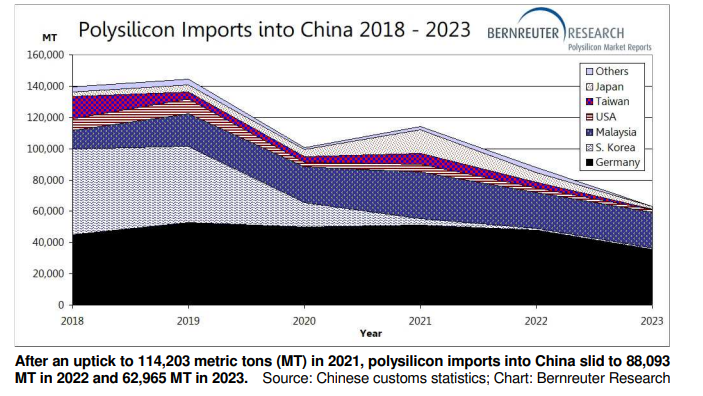
Polysilicon Imports into China
Analysis of silicon metal suppliers and many other market trends
Chinese import data from 2011 through 2022 are contained in the Polysilicon Market Outlook 2027. In particular, the new 102-page report analyzes the impact of the Uyghur Forced Labor Prevention Act and reveals who the main silicon metal suppliers of the top seven polysilicon manufacturers in China are. The report also provides sophisticated scenarios of supply and demand, detailed forecasts of polysilicon prices through 2027, the latest purity and cost data on the dominant Siemens process and fluidized bed reactor technology, as well as many other market trends. For more information on the report, please go to the Polysilicon Market Outlook 2027.


